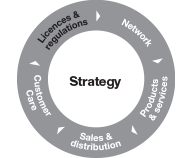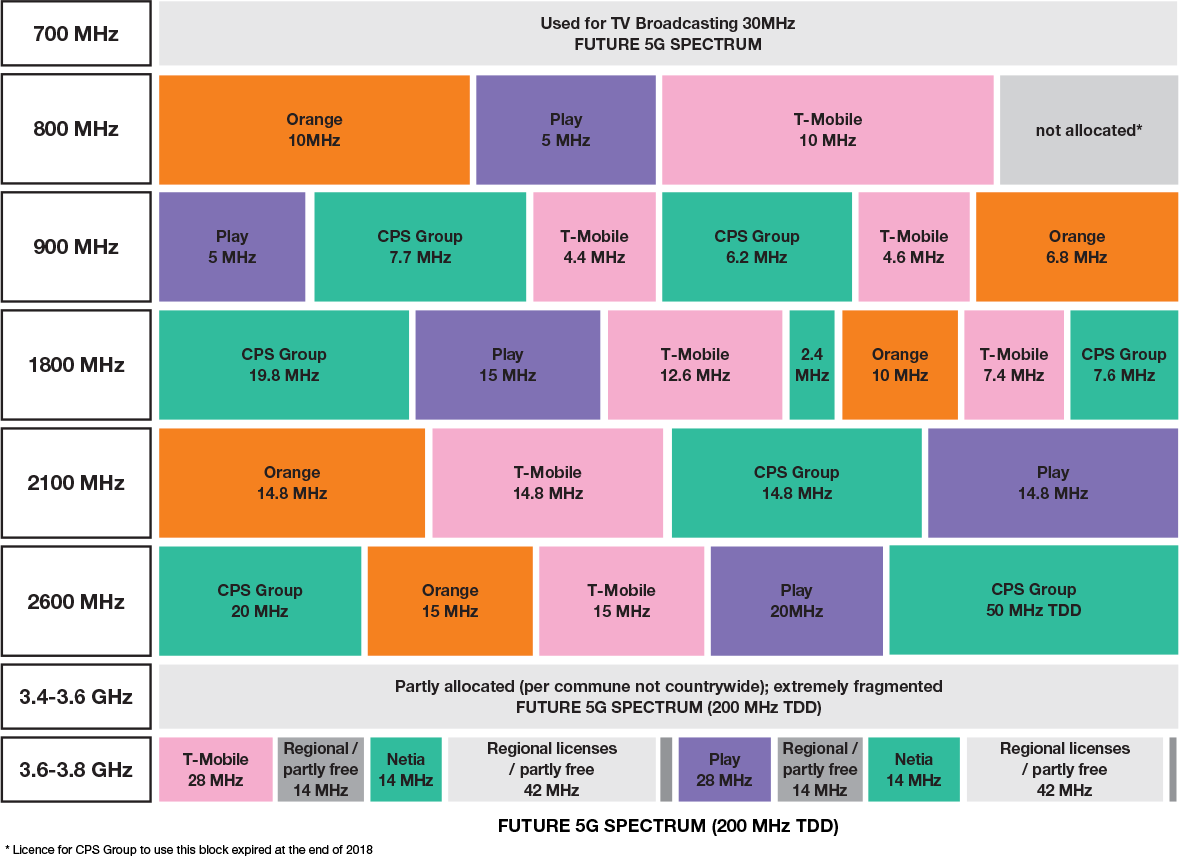
Business model
Licences and regulations
TTo be able to render mobile telecom services we require access to radio spectrum. The amount of spectrum that is at our disposal influences the competitiveness and quality of the services we render and ultimately the customer experience. This is especially important in the light of huge growth in mobile data consumption. Our competitive position in radio spectrum significantly improved in 2016 following completion of the relevant auction towards the end of 2015. As a result of the auction we acquired 10 MHz spectrum in 800 MHz band (the maximum that was allowed) and 15 MHz spectrum in 2600 MHz band.
In order to continue to assure the best customer experience we need to continuously optimise our effective use of spectrum. Taking into account growth of LTE data traffic and lower needs for 3G and 2G services, we decided to start the process of spectrum re-farming to newer technologies, with focus on 4G layer extension. As for today we have already finished re-farming of 900 MHz band from 2G to 3G, allocating twice more spectrum resources to 3G technology, while only small part of the bandwidth is currently dedicated to 2G services. We still continue re-farming of 1800 MHz and 2100 MHz to 4G. Currently 44% of LTE 1800 sites are working in the model of sharing infrastructure (MORAN). In case of band 2100 MHz, changes in 11 agglomerations have been made already. As a result of all changes the amount of spectrum dedicated to LTE/4G network capacity will increase by 38%. Re-farming also means that we are changing the model of cooperation with T-Mobile regarding 900 MHz and 1800 MHz bands from the one based on co-usage of spectrum (MOCN) to the one based on sharing infrastructure (MORAN). This means we do not share frequencies anymore, but thanks to optimization of all frequency resources, we can offer more capacity to our customers.
Future development of 5G services will require the acquisition of necessary frequency resources. It is assumed that three bands will be used for 5G network: 3.4–3.8 GHz, 700 MHz and 26 GHz. None of the above bands is available today. 3.4–3.8 GHz bands are partially allocated but very fragmented. As a result, frequency allocation process has to be preceded by comprehensive rearrangement of this spectrum, both activities are in the responsibility of the market Regulator and the government. We estimate that band 3.6–3.8 GHz will be available as first. According to the plan published by the President of UKE the formal preparations will start in May 2019. At first UKE will initiate proceedings regarding refusals to extend the reservation periods for the current users of this frequency band. The allocation procedure is likely to start in 2020, and the reservation decisions should be issued by mid-2020. 700 MHz band is currently in use by TV broadcasters and is required to be available by 30th of June 2022. However, the availability of this part of spectrum also depends on international arrangements. 26 GHz band can also be available after some rearrangements, it can be expected that allocation of that part of spectrum will be no earlier than in 2020. The allocation processes for 3.4 – 3.6 GHz band may take place in the year 2022 or later.
Current distribution of frequencies for the 700–2600 MHz bands and 3400-3800 GHz bands

Details of telecommunications licences
| (in PLN millions) Acquisition | Acquisition date | Years to expiration (2) | Net book value | |
|---|---|---|---|---|
| At 31 December 2018 | At 31 December 2017 | |||
| 800 MHz | 2016 | 12.1 | 2,471 | 2,676 |
| 900 MHz | 2014 | 10.5 | 252 | 276 |
| 900 MHz(1) | 2013 | - | - | 7 |
| 900 MHz(1) | 2018 | 2.0 | 24 | - |
| 1800 MHz(1) | 2013 | 9 | 143 | 159 |
| 1800 MHz | 1997 | 8.6 | - | - |
| 2100 MHz | 2000 | 4.0 | 384 | 479 |
| 2600 MHz | 2016 | 12.1 | 95 | 103 |
| Total telecommunications licences | 3,369 | 3,700 | ||
(1) Licences held under agreements with T-Mobile Polska S.A
(2) Remaining useful life in years as at 31 December 2018